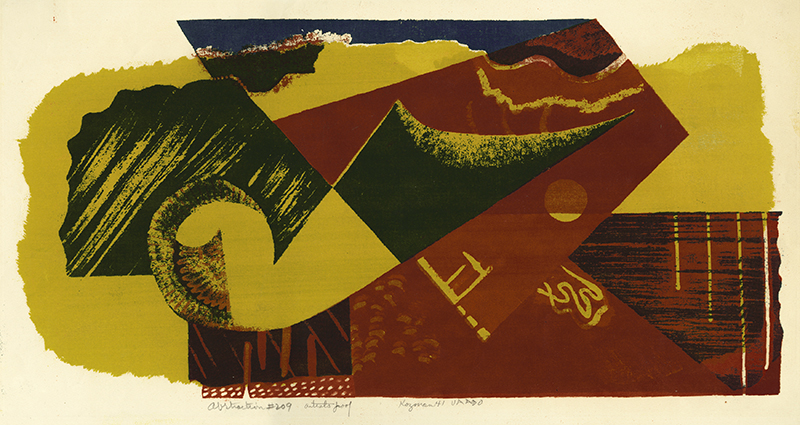Abstraction #209 is a color serigraph (screenprint) created in 1941 by American artist Myron Kozman. It is pencil signed, dated, titled, and inscribed “UAA90.” This impression is an artist’s proof outside of an edition of 10. It was printed by the artist on cream wove paper and was published by the WPA Federal Art Project Graphic Arts Division, Chicago. The image measures 10 x 20-1/4 inches.
Abstraction #209 is an excellent example of Kozman’s creative exploration of the medium of screenprint. He eschewed the overworked commercial aspects of the screenprint process and pushed the medium toward the expressiveness of painting with his choice of colors, patterns, and shapes, sometimes layered sometime not, to create non-static imagery. In the New Bauhaus, students didn't worry about titling their work and that seems to have carried forward to Kozman’s series of abstract screenprints which were numbered abstractions. Each one seems to be inscribed “UAA90” but the meaning of the annotation remains unsolved.
Myron Kozman, painter, sculptor, printmaker, photographer, and teacher, was born to Joseph and Margaret Kozman in Muncie, Indiana on January 3, 1916. He attended the Ottawa Hills High School in Cedar Rapids and completed one year of study at the Cedar Rapids Junior College in 1935. During the late 1930s, Kozman produced several abstract paintings for the Works Progress Administration which were displayed in public venues around Chicago. Under the auspices of the WPA, Kozman learned serigraphy, which he later taught to Moholy-Nagy.
Kozman had just moved from Grand Rapids to Chicago when he “bumped into the Bauhaus.” He received a scholarship in 1937 to the newly opened New Bauhaus which was directed by Moholy-Nagy. It was located at 1905 North Prairie Avenue, the former home of Marshall Field, and Kozman was one of five students in the first graduating class of 1942. The other graduates were Juliet Kepes, Nate Lerner, Charles Niedringhaus, and Grace Seelig. In an interview in 1999, he described the New Bauhaus: “We were not, as many thought, an art school; we actually were—it was a school for life, if we could give it any kind of a title, because we found the relationship between everything we were doing and living, so that there was no specialized inside or outside of the school, we just encompassed the whole world, or so we thought.” As Kozman's close friend and mentor, Moholy-Nagy encouraged his interest in avant-garde techniques such as photograms (the dripping of emulsion on photographic paper) and screen printing.
Kozman registered for the World War II draft on 16 October 1940 but it seems that he was allowed to complete his studies at the New Bauhaus. As he was headed for the campaign in Europe, Moholy-Nagy gave him letters of introduction as a graduate of the New Bauhaus and professor. With this support, Kozman met Gertrude Stein, Picasso, Henry Moore, and Brancusi. Upon his return to the United States in 1946, Kozman began working as an instructor at the Chicago School of Design (formerly the New Bauhaus). In 1948 he married Lois Field, who also an accomplished visual artist. Kozman continued teaching visual design and printmaking at the Institute of Design (formerly the Chicago School of Design) until 1954.
In the1960s, Kozman moved to Milwaukee, Wisconsin where he served as the head of the design department at the Milwaukee Institute of Art and Design. During a telephone interview with Elizabeth Siegel in 1999, Kozman stated that "I still teach, and the only way I can teach is à la Bauhaus, and I’m permitted to do that wherever I went. I did that in Milwaukee, and I did it here in Webster Groves, Missouri…And I stick with that, so I’m still teaching at Lindenwood University in Saint Charles, Missouri.”
Kozman was primarily known for this work in Abstract Expressionism and his work is in the collections of the Baltimore Museum of Art; the Gibbes Museum of Art, Charleston; the Art Institute of Chicago; the Smart Museum of Art, the University of Chicago; the Metropolitan Museum of Art and the Museum of Modern Art, New York; the Portland Art Museum, Oregon; the Library of Congress, the National Gallery of Art, and the Smithsonian American Art Museum, Washington, D.C.
Myron Kozman died on 12 July 2002 in St. Louis, Missouri.



